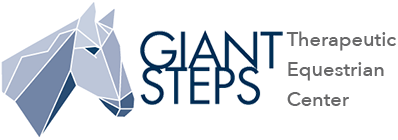By Violet Barnett, Communications Intern
Driving by the Giant Steps arena, the glowing smiles on the faces of children and adults alike can be seen even from the road. On the ground, Giant Steps riders face challenges like walking, talking, making friends, and following directions. However, on horseback, riders conquer these challenges, all while improving skills to help in their daily lives.
Autism is a mental condition that affects more than a third of Giant Steps riders. Characterized by difficulty in communicating and forming relationships, it affects children and adults. While Giant Steps instructors, volunteers, and parents have stories identifying the positive effects of therapeutic riding, recent studies have confirmed what they knew all along. A recent experiment done in Colorado measured the behavior of autistic children who rode to that of those who didn’t. They found that, “children with autism who took therapeutic horseback riding lessons became less irritable, less hyperactive, spoke more words, and showed other improvements, compared to children who didn’t ride.” [Citation 1] Other studies showed that people with autism who were involved with horses had increased eye contact, and desire to learn. [Citation 2]
Time with horses does for those with autism what no classroom can—it gives them connection. A similar study in Maryland showed that children involved in a therapeutic riding program work more effectively with others. [Citation 3] A bond with a horse is truly life changing, and providing this to those in our community has shaped the lives of Giant Steps’ riders and their families.
For at least one of our riders living with autism, her weekly lesson is the highlight of her week. Her mother reports that the staff at Giant Steps, including the horses of course, have boosted her daughter’s confidence significantly. In the past, her daughter experienced a lot of anxiety, which would cause her to act out. In the saddle, her daughter looks relaxed and comfortable. Says this mom, “I believe it is the best medicine she has.”
Citations:
-
Gabriels, R. L., Pan, Z., Dechant, B., Agnew, J. A., Brim, N., & Mesibov, G. (2015). Randomized controlled trial of therapeutic horseback riding in children and adolescents with autism spectrum disorder. Journal of the American Academy of Child and Adolescent Psychiatry, 54(7), 541-549. doi:10.1016/j.jaac.2015.04.007 [doi]
-
Stewart, Barbara. “Healing With the Power Of Horses; Therapists Use Riding To Help Treat Disabilities.” The New York Times. The New York Times, 19 June 1998. Web. 12 June 2017.
-
“Benefits of Therapeutic Riding for Children with Autism Extend to Classroom.” William and Mary. N.p., n.d. Web. 12 June 2017.


